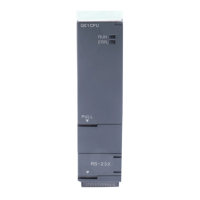5
MEMORIES AND FILES USED IN CPU MODULE
5.2 High Performance Model QCPU, Process CPU, Redundant CPU, Universal Model QCPU
5.2.4 Standard ROM
5 - 29
1
Overview
2
Performance
Specification
3
Sequence Program
Configuration and
Execution Conditions
4
I/O Nunber Assignment
5
Memories and Files
Handled by CPU Module
6
Functions
7
Communication using
built-in Ethernet ports of
CPU module
8
Communication with
Intelligent Function
Module
(4) Write to standard ROM
The method of writing data to the standard ROM differs depending on the CPU
module.
(a) High Performance model QCPU, Process CPU or Redundant CPU
• Choose [Online] [Write to PLC (Flash ROM)] [Write the program memory to
ROM...] on GX Developer to batch-copy the program memory data to the
standard ROM. ( Section 5.2.7)
• Choose [Online] [Write to PLC (Flash ROM)] [Write to PLC (Flash ROM)] on
GX Developer to write data to the standard ROM. ( Section 5.2.7)
• Use the automatic write of all data from memory card to standard ROM.
( Section 5.2.8)
(b) Universal model QCPU
• Choose [Online] [Write to PLC ] on GX Developer, and select "Standard ROM"
as the target memory to write the program memory data. ( Section 5.2.2)
Select "Standard ROM" as the target memory to write the program memory data.
POINT
The file size has the minimum unit. ( Section 5.4.4)
The occupied memory capacity may be greater than the actual file size.
Note that as the number of files rises, the difference between the occupied
memory capacity and actual file size increases.
Remark
Refer to the sections above for details of the selection, applications, procedures
and precautions for the standard ROM wiring methods.
(5) How to use the program stored in the standard ROM
The programs stored in the standard ROM are booted (read) to the program memory
to perform operations.
Note5.6
( Section 5.2.9)
Note6
Note6
Universal
UD
Note5.6
The Universal model QCPU cannot boot programs from the standard ROM to the program
memory. ( Section 5.2.3)
Universal
UD
Note5.6

